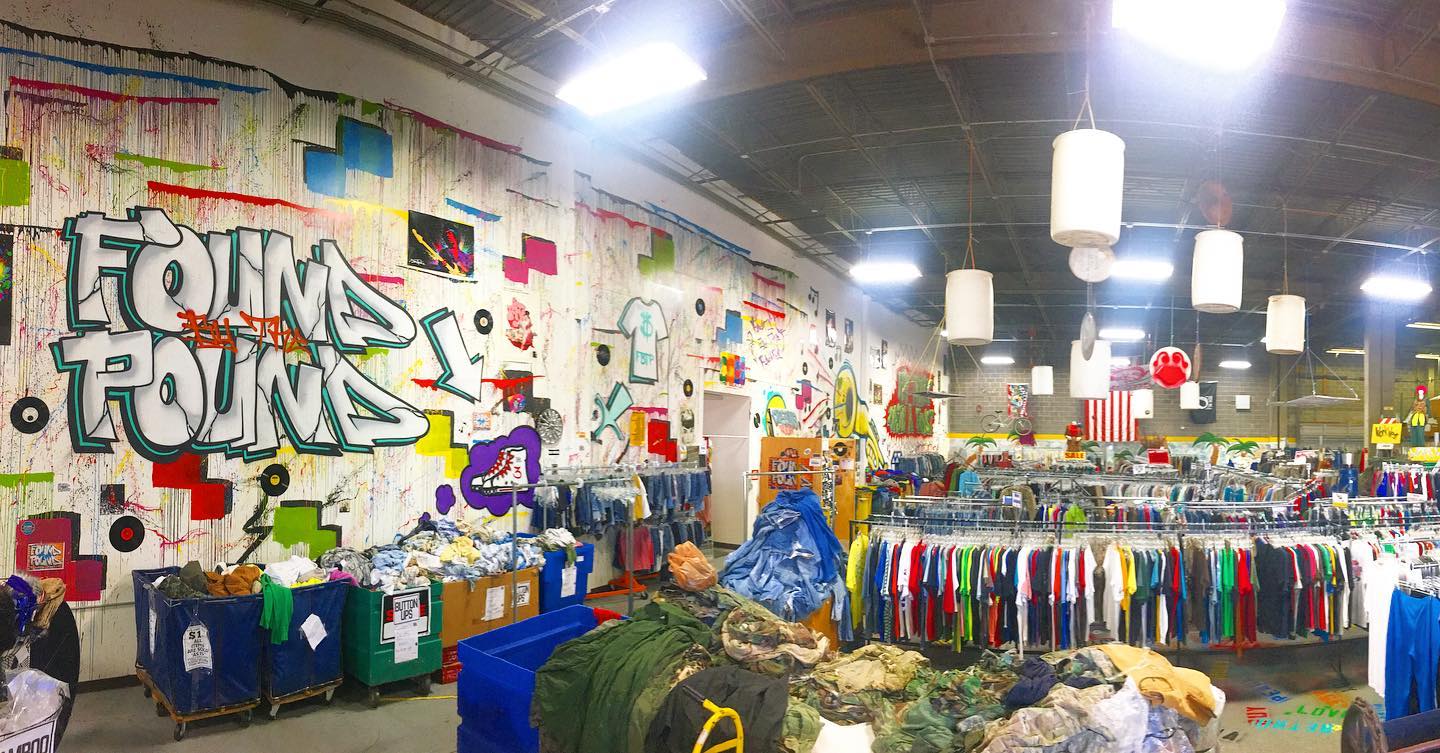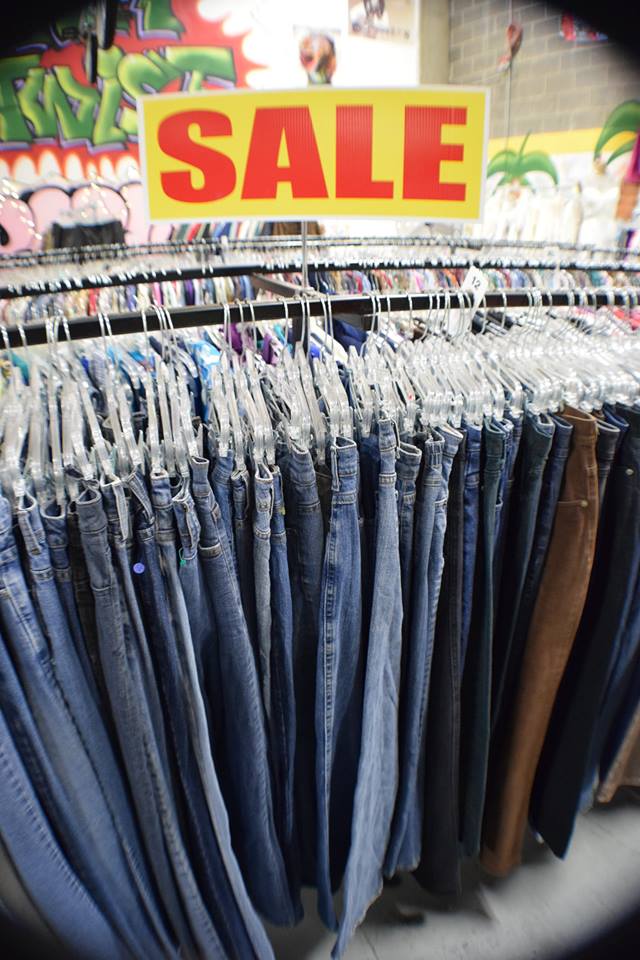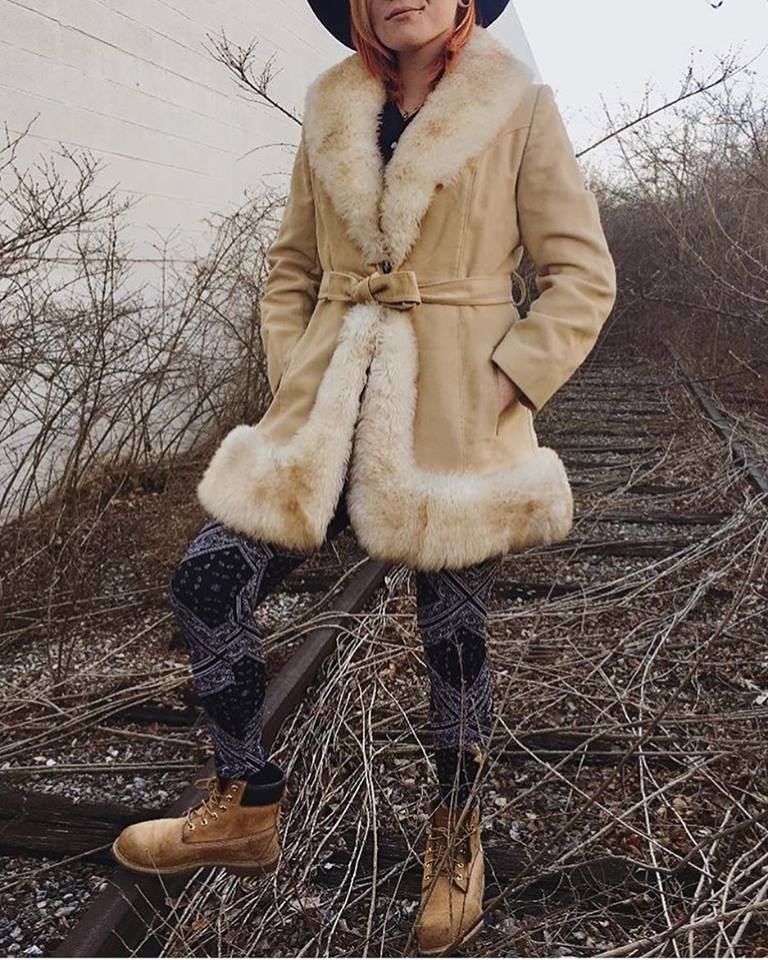Photos by Found by the Pound & Pulpy Thrift
One of the most basic ways you can reduce your waste as an individual is participating in the secondhand market, but most people don’t realize that thrifting goes far beyond your local Goodwill or Salvation Army. People living in isolated areas may not even have access to these brick-and-mortar stores.
Luckily, buying pieces in-store and online has never been easier. Thanks to minimalism and the Marie Kondo Effect, the secondhand market is flushed with high-quality items that surpass what you’d find at your average Forever 21.
To talk about this, I had the pleasure of interviewing three thrift business workers from my hometown: Meag Moore of Pulpy Thrift, Gabe Clifford of Vintage_314, and Molli Bonini of Found by the Pound. My hope is that their insight will help you transition into a thrifting enthusiast no matter where you live, whether you’re an aspiring buyer, seller, or general appreciator.
What do you love about thrifting?
Meag: I love lots of things about thrifting: the thrill of the hunt, never knowing what I’ll find that day. But the thing I love most about thrifting is giving something new life. Especially when I find something incredibly niche and perfect for someone I know–something they only ever touch because I happen to feel like going hunting for vintage that day.
Gabe: I love everything about thrifting, I love finding stuff that makes me happy. Nothing beats finding something I love or have wanted forever in a thrift store.
Molli: There are so many things I love about thrifting! Simply the cost of lightly used items compared to brand new ones is enough to make a person consider thrifting. Finding both high dollar vintage, quality name-brands, and home furnishings for a fraction of the tag price drives my consistency with shopping secondhand. I also love the uniqueness of the thrifting experience. Not only are no two stores alike, but a majority of the merchandise inside is also one-of-a-kind, and the inventory changes constantly. Name-brands aside, the “funky retro” selection of any thrift store defies modern style and fast fashion trends, perfect for those who dress–and are–a little outside the box. Also, the thrill of the hunt makes for an exciting adventure any time you visit. You never know what you’ll find, and I love that! Last but not least, I consider the positive environmental impact thrifting makes on the world. Recycling & reusing–including reWEARing–is a very big part of sustainability.
How did you start thrifting professionally?
Meag: I started reselling because I didn’t want to leave a part time job I love. I work with kids on the spectrum; the pay ain’t great, but I really like what I do and how many twenty-somethings have that? I started selling on Instagram as a side hustle and now I’m able to keep the gig I love by doing something I was already doing for fun.
Gabe: I started thrifting full time in 2015. I just quit my job and wanted to do that! Opened the store witch was called afterlifevintage and it was an amazing experience.
Molli: Unlike other self-owned e-commerce stores, I began my “Resale Career” by gaining employment as a sales associate at an already established thrift store. I happen to be browsing the area for rental homes, saw a yard sign that said “NEW THRIFT STORE” and thought I would check it out, just as a customer. Someone who worked at a neighboring business told me I should work there, so I applied! Since then, I have worked my way to a higher-level position, co-developing the business’s boutique location. I had no idea how much I would LOVE resale, to the point I do a little bit on the side for myself. Now that I’ve started, I don’t think I’ll stop!
How do you buy and sell secondhand goods?
Meag: At the moment, I sell thrifted vintage and nostalgia stuff online only through Facebook, Instagram, Depop, and eBay. Pretty much every platform with little to no seller fees. I’m especially romanced by stuff from my own childhood (late 80s-early 90s).
Gabe: I had a brick and motor for almost a year but decided to go back to selling online. That decision meant I could thrift more and do other jobs at the same time.
Molli: We primarily sell in a brick-and-mortar, (one location in North County, the other in South City) but use Etsy for specialty and high dollar items, or to ship items to people who don’t live in St. Louis. We use Instagram to advertise and sell merchandise, whether it’s simply getting folks interested in walking through the door to shop, or to reach out-of-state customers.
What’s the best or weirdest thing you’ve ever found second hand?
Meag: The best thing I think I’ve found, money wise, was a vintage 90’s Tommy Hilfiger color block coat from one of their runway shows. It was a killer find & selling it got my car a new tire. I find weird things every time I go thrifting, so its hard to choose – probably my ever growing kewpie/creepy naked baby collection. I feel bad for the little weirdos & gotta take em home; my partner has banished them to my office! I’ve also been known to keep pet photos I find in cool thrifted frames because I don’t have the heart to throw Fluffy out.
Gabe: This is a hard one. I’ve found so many awesome things. My favorite was a 1975 Jimi Hendrix memorial tour shirt in perfect condition. I found it along with 3 1977 Grateful Dead shirts. And the coolest part about it was I found it in a hole-in-the-wall store ten minutes from my house. And the old man said they had been hanging up for 10 years. I thought that was the coolest thing. It was meant to be for me to find those. It was a baseball card shop and he had all his old concert shirts hung up!
Molli: The best thing I’ve found thrifting…this is a tricky one! It’s a three-way tie: A 1960’s Authentic Cheetah Fur Coat (just like the one Jackie Kennedy wore), a rare 1994 Dr. Dre Tee valued at over $500, and a right-off-the-runway patchwork skirt form Oscar De La Renta.
Why is thrifting important?
Meag: Thrifting is so important to combating fast fashion. There’s a treasure trove of stuff you’ll love in great condition at a great price if you only go looking online or in person. Rubber, leather and textiles make up about 9-10% of municipal solid waste in the USA according to EPA estimates. That means the average American throws out 80-ish pounds of clothes every year. It’s gross. Looking up the stats will blow your mind – it definitely made me look at my consumption & what I choose to throw away vs. donate differently.
Gabe: Thrifting is important because it’s like recycling, someone donates it gets put out, and then some one buys the old shirt. I think it’s a huge difference as to buying new clothes from the mall. Second hand buying is very important in many ways. Saves you money and saves the world!
Molli: From transporting raw materials to production processes, clothing manufacturing requires a lot of energy. It takes 1800 gallons of water to produce the cotton in ONE pair of jeans. Thrifting respectfully keeps the resources invested in the clothing items from going to waste. The mere energy that goes into finished clothing getting to retail stores, and “the back end” of the disposal of unwanted materials…all can be preserved with a lesser demand for new clothes. There are also those unwanted materials, harmful dies, and crude oil by-products are often dumped into areas surrounding clothing factories polluting water supplies. On top of the environment, thrifting supports human rights. Worker rights, labor laws, (working conditions, wages, age requirements, hours worked) are not well regulated in areas where apparel is mass-produced. Often workers in make less than 75$ a month, working 16 hour days in unfavorable conditions. The Bangledeshi Textile Factory Disaster highlights the dangers faced by workers, the majority being women, in the clothing industry.
Why should others participate in the second hand market?
Meag: I think everyone should participate in recycling. Obviously there’s limitations & obstacles to find specific items – but I swear I always manage to find the exact thing I need second hand or handmade now that I’ve surrounded myself with thrift on social platforms. It’s great for the environment, it should be cost-effective for everyone & it makes your home look cooler. Challenge yourself to support your local makers & vintage lovers for a year of birthday gift giving – you’ll be hooked for life.
Gabe: I think others should get into thrifting because again it’s like recycling: It is very important. It saves our planet and saves you money!
Molli: Everyone should thrift, and encourage others! The positive environmental impact can’t be overlooked. Despite the old taboo of shopping secondhand, that “dirtiness” people associate with used items, that can be fixed with a washer/dryer, and it is nothing compared to the dirtiness of the retail/clothing industry. The financial benefits are unlike any other shopping experience, and there is almost nothing “new” out there you can’t find secondhand. In addition to saving money, thrifting can MAKE you money! With modern apps like Instagram, depop, Etsy, and Ebay, modern resale-despite being one of the oldest hustles known to man-is now easier than ever.
Learn More About Rethinking Sustainability






